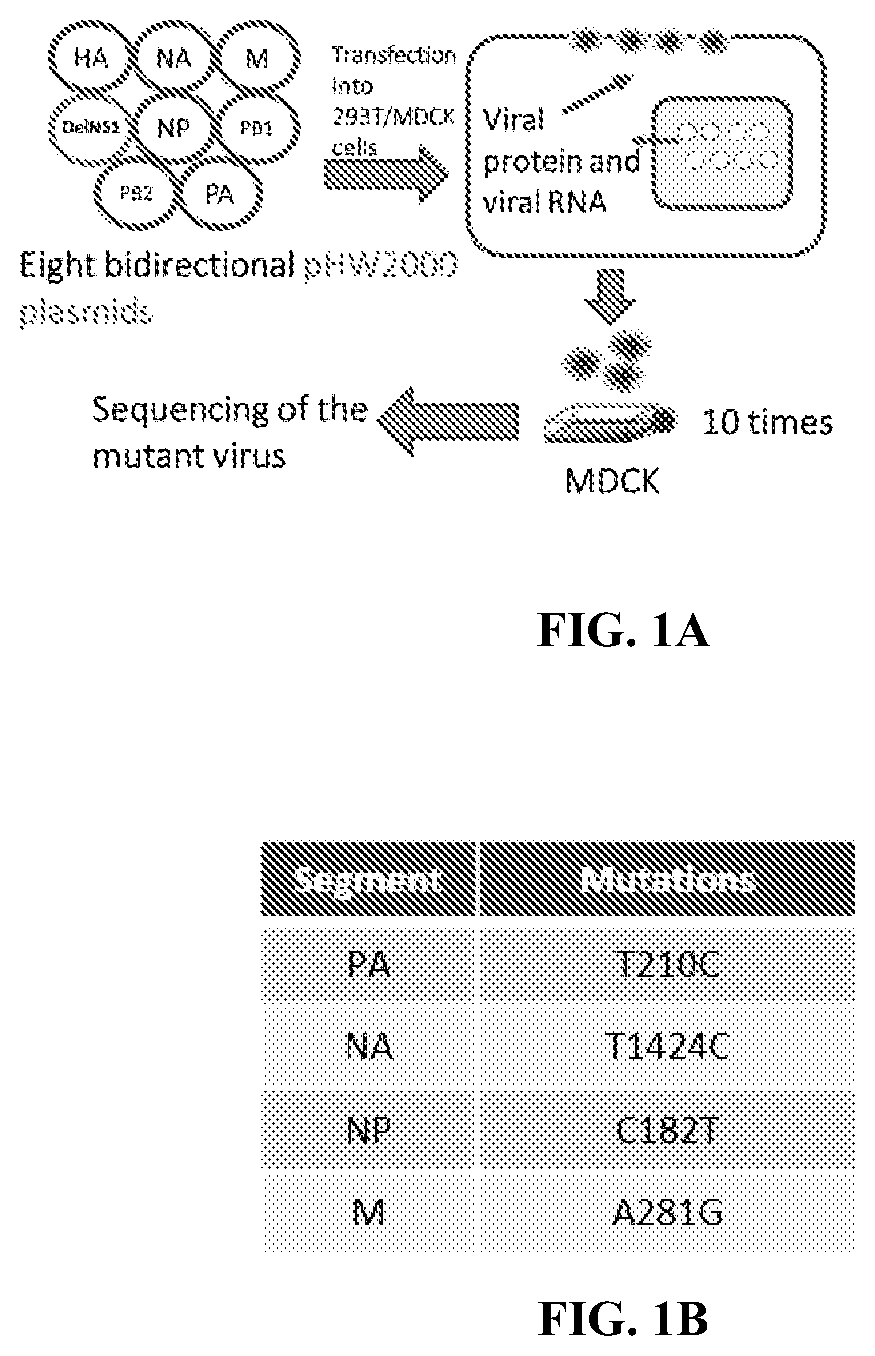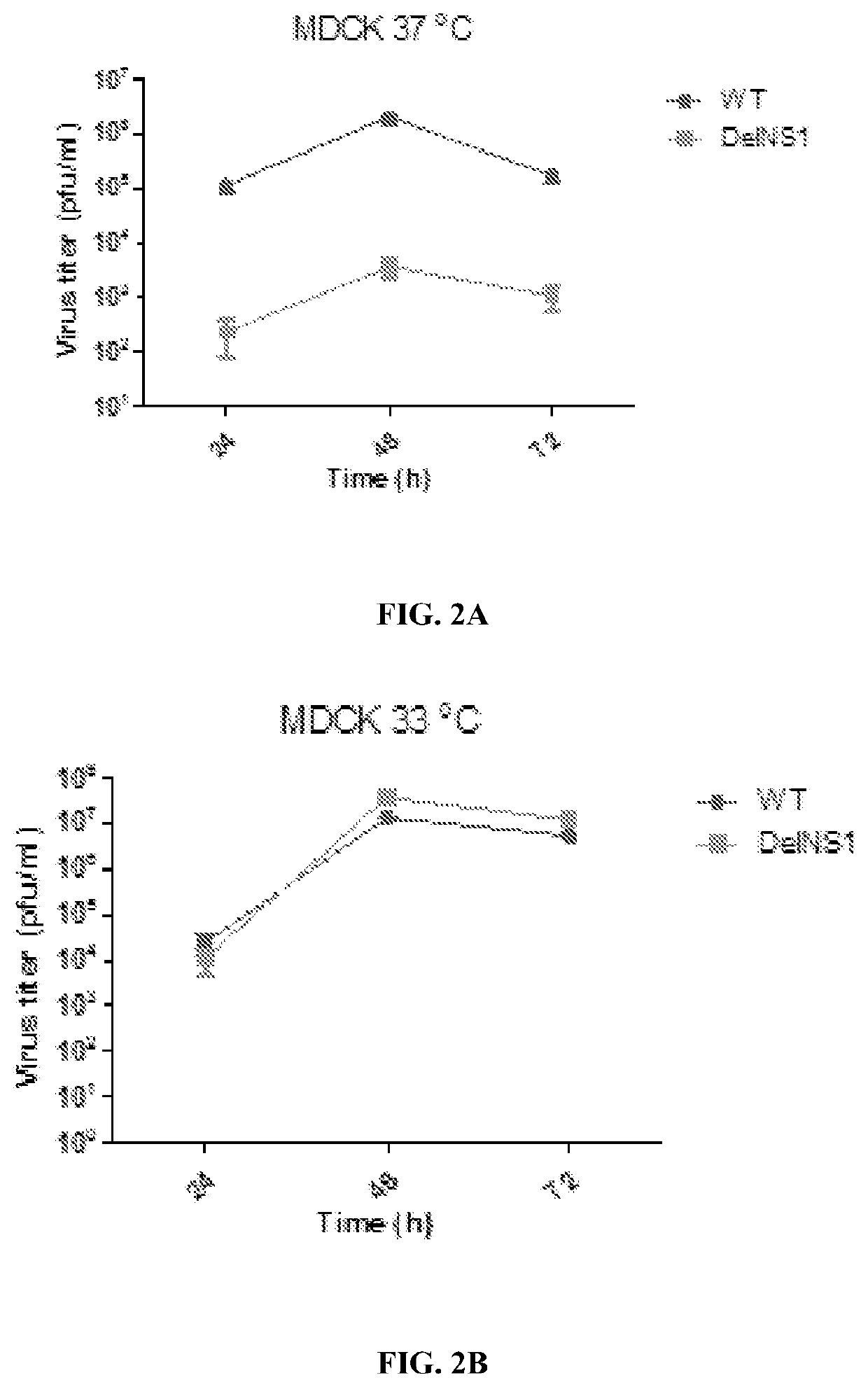Live attenuated influenza b virus compositions methods of making and using thereof
a technology of attenuated influenza and compositions, which is applied in the field of live attenuated influenza virus, can solve the problems of difficult to produce high titers of attenuated virus for vaccine applications, difficult to predict the trend correctly each year, and marked reduction of the growth of the other two viruses in embryos of this ag
- Summary
- Abstract
- Description
- Claims
- Application Information
AI Technical Summary
Benefits of technology
Problems solved by technology
Method used
Image
Examples
example 1
n and Characterization of DelNS1 Influenza B Live Attenuated Virus Vaccine
[0103]A clinical isolate, B / Hong Kong / 8038 / 2011, which was confirmed to be the Victoria lineage by sequence analysis, was used in these experiments. Coding region of the NS1 gene was removed from viral genome without affecting the expression of other essential genes for virus replication (FIG. 1A).
[0104]Eight pHW2000 plasmids, containing the DelNS1 segment and the other 7 influenza virus segments, together with an NS1 expression plasmid, were transfected into a 293T / MDCK cell mixture and incubated overnight. The DNA mixture was removed and MEM supplemented with 1 μg / ml N-tosyl-L-phenylalanine chloromethyl ketone (TPCK)-treated trypsin (Sigma) added. Virus supernatant was collected 72 h later and designated passage 0 (P0) virus, and then subsequently passaged in MDCK cells or embryonated chicken eggs.
[0105]Initial rescued DelNS1-8308B influenza B virus, obtained from transfected 293T cells at 37° C. for 72 hour...
example 2
operties of DelNS1 Flu B Virus in MDCK and A459 Cells
[0106]Growth kinetics of DelNS1 virus were estimated in MDCK and A549 cells at 37° C. and 33° C. degrees respectively. Confluent cells (A549 or MDCK) seeded in 24-well plates were infected with viruses at the indicated multiplicity of infection (MOI). After 1 h adsorption, viral supernatant was removed, the cells washed twice with phosphate-buffered saline (PBS), then overlaid with MEM containing 1 μg / ml TPCK trypsin and incubated at the indicated temperature. Supernatants were 447 collected at different time points and titered by plaque assay in MDCK cells.
[0107]Plaque assay: Viruses were 10-fold serially diluted and added to confluent MDCK cells in 6-well plates, then incubated at 37° C. for 1 h. Supernatant was removed and cells washed twice with PBS and then overlaid with 1% MEM agarose containing 1 μg / ml TPCK trypsin. Plates were incubated at 33° C. for 48 h and then fixed with 10% PBS buffered formaldehyde solution for at le...
example 3
n of Lethal Challenge by Mouse Adapted Flu B Viruses with DelNS1 Flu B Vaccine
[0110]Mice were vaccinated with DelNS1 Flu B vaccine (Victoria lineage, 2×106 pfu) ONCE through nasal drop.
[0111]After three weeks, vaccinated mice were subsequently challenged with either one of mouse adapted flu B viruses, B / Florida / 4 / 2006 (Yamagata lineage, 5×105 TCID50)—and B / Brisbane / 60 / 2008 (Victoria lineage, 5×106 TCID50). Body weight and survival rate of the mice were recorded for 2 weeks. Mice with body weight loss greater than 25% were euthanized, in accordance with animal ethics guidelines. To evaluate viral replication in mouse lungs, lungs were collected at day 3 and homogenized in 1 ml PBS. Viral titers were determined by plaque assay in MDCK cells.
[0112]DelNS1 flu B virus is not virulent to mice, even when challenged with the highest dose of virus (FIGS. 3A and 3B). To assess if DelNS1-B8038, a Victoria lineage influenza B virus, protects from infection with both lineages of influenza B viru...
PUM
| Property | Measurement | Unit |
|---|---|---|
| temperatures | aaaaa | aaaaa |
| temperatures | aaaaa | aaaaa |
| temperatures | aaaaa | aaaaa |
Abstract
Description
Claims
Application Information
 Login to View More
Login to View More - R&D
- Intellectual Property
- Life Sciences
- Materials
- Tech Scout
- Unparalleled Data Quality
- Higher Quality Content
- 60% Fewer Hallucinations
Browse by: Latest US Patents, China's latest patents, Technical Efficacy Thesaurus, Application Domain, Technology Topic, Popular Technical Reports.
© 2025 PatSnap. All rights reserved.Legal|Privacy policy|Modern Slavery Act Transparency Statement|Sitemap|About US| Contact US: help@patsnap.com



